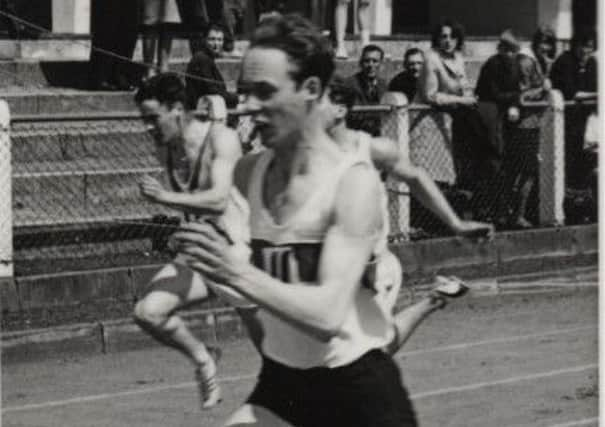Scottish sprinter Les Piggot crossed the '˜great divide'


First run in 1870 at Powderhall, its home for the first 100 years of its existence, it was known as the Powderhall Sprint and was the jewel in the crown of what was, until some 30 years ago, exclusively professional sprinting. Since then the event has been open to all, the “Berlin Wall” that previously existed between the professional and amateur codes of the sport having been dismantled.
During that sporting apartheid, amateur authorities looked down their noses at professional athletics, considering it contaminated with filthy lucre and dodgy betting deals which fell foul of their lofty Corinthian ideals. Despite such attitudes, what remained undeniable was that the professionals did produce some outstanding sprinters in pursuit of Powderhall success.
Advertisement
Hide AdAdvertisement
Hide AdOne athlete who in one sense crossed the great divide was Les Piggot of Garscube Harriers, who had a stellar amateur sprinting career; twice an Olympian in 1968 and 1972, twice finalist in Commonwealth Games 100m in 1970 and ’74, several times Scottish champion, 53 times a British international and occasional captain of the British team.
After the Mexico Olympics in 1968, he took the rather risqué step of turning professionals to improve his performance, at a time when a rule prohibited amateurs from even training with pros. There was, however, one particularly good precedent in his favour – Eric Liddell, who almost 50 years earlier trained at Powderhall under professional coach Tom McKerchar.
The late Crawford Fairbrother, the famous Scottish and British high jump champion, took Piggot to Powderhall to meet top professional trainer, Jim Bradley, pictured below.
Between 1963 and 1971 Bradley produced five winners of the Powderhall Sprint and throughout his career numerous other high-class sprinters. After initial pleasantries, Piggot was surprised to be told by him, “You run poorly.” He recalled: “Bearing in mind that at this time I would say I was among Britain’s top three sprinters not long back from the Mexico Olympics, I was not expecting that! He said he had studied my running action on TV and that I was only a ‘legs runner’, that my arms did nothing to assist me, but instead swayed across my torso.
“His belief was that the arms led the legs and had to be built up, principally through the boxer’s speedball. He said if I was to be trained by him he would put about four yards on me but added that would be subject to two conditions.
“First, that I would not turn pro, as he wanted to demonstrate that his methods could also bring success to top amateurs. Secondly, I would do no running of any kind for the first four months, to enable me to forget my ‘poor’ running technique. I would spend that time doing only gymwork, especially speedball and an exercise circuit using bodyweight resistance as he did not believe in weights.”
Use of the speedball was key to Bradley’s methods, requiring his athletes to do six “three-minute rounds” with a minute rest in between. Piggot started training alongside runners such as George McNeill, Wilson Young and another amateur better known as a rugby winger, Gil Borthwick, of Heriot’s and London Scottish. The gym work took place at a small hut Bradley had rigged up at Saughton Enclosure where, under his eye, Piggot’s technique was adapted to the trainer’s demands with emphasis on rhythm and strength.
Frequent rubs were another important part of the schedule, usually done by Bob Pringle, Bradley’s colleague. Piggot found his training companions supportive and came to understand how much they regretted not being eligible to run for Scotland because of their pro status.
Advertisement
Hide AdAdvertisement
Hide AdThe emphasis on track training was quality, not quantity, with no session exceeding 25 minutes. All running was done from marks to ensure maximum competitiveness and at no time did Piggot run further than 120 yards. Bend running was not allowed and on occasions balaclavas had to be worn if onlookers trying to pick up betting pointers were present. All was done to Bradley’s highly demanding and disciplined standards, which were not to be breached. His preparation was extremely thorough and his methods had been proved so successful that Piggot had total confidence in him.
On occasion he undertook special “preps” before important races. Bradley would personally cook the best cuts of steak for him which he had sourced through Pringle’s connections at Edinburgh meat market. That had to be eaten with chips cooked in a special oil, as Bradley considered boiled potatoes were no good. Only Jamaican coffee was to be drunk after a meal and for ten days before the race, each night Piggot had to drink a concoction of sherry, whisked egg, milk and sugar.
This was a world apart from Piggot’s amateur training with its conventional methods and lengthy repetitive sessions. Gradually, Bradley’s coaching began to pay off as his times improved. Some amateurs were displeased at his involvement with those “from the other side”, including David Jenkins and former national coach John Anderson who raised the breach of the strict amateur rules with officialdom. As a result Piggot was interviewed prior to the 1970 Commonwealth Games by top official, Willie Carmichael, who gently reminded him of his obligations as an amateur international.
By the time Bradley left for Australia in the early 1970s, Piggot’s best 100m time had improved from 10.6secs. to 10.3, equivalent to a gain of three yards. He had delivered what he promised and though some amateurs thought professionals a lesser species, there is no doubt Bradley was in a class of his own as a coach.